Engineering Proposals: Free Template + 12 Proposal Writing Tips
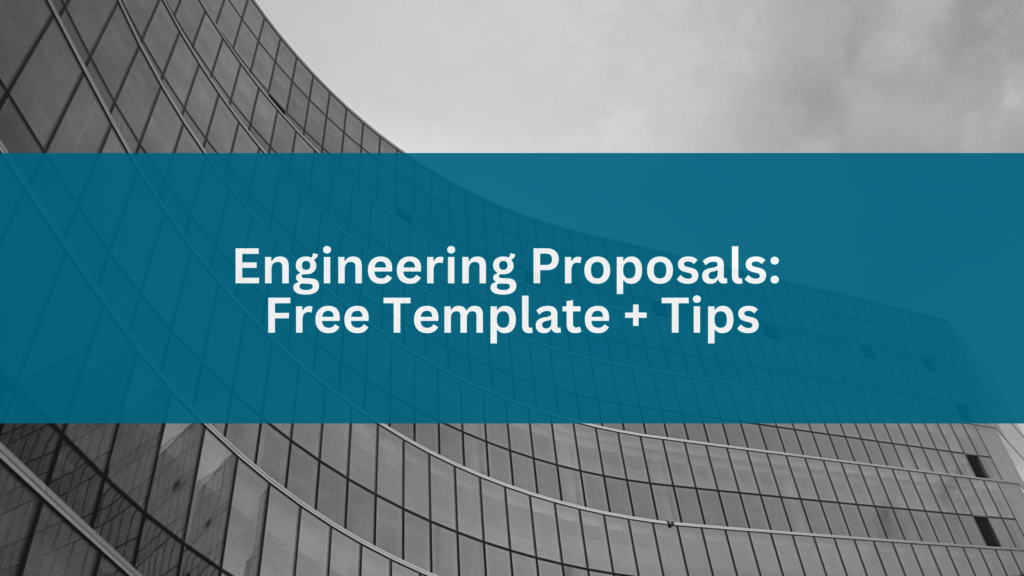
An engineering service proposal is a standardized document pivotal in guiding the selection of consultants. The engineering proposal is more than just a document; it’s your opportunity to showcase expertise, understanding, and value among the piles of proposals.
Whether you’re a seasoned engineering consultant or a firm stepping into the arena of important projects, your ability to craft a compelling proposal can make all the difference in placing your business ahead of the competition. After all, in 2023 alone companies sourced 39% of their revenue from RFPs.
However, mastering the creation of such a proposal is a complex task. For those wanting to successfully navigate this process, you must be ready to grasp the fundamental concepts of engineering proposals. But what exactly does that include?
In this blog, we’re covering everything there is to know about writing engineering proposals. From what to include in your engineering proposal and writing tips to engineering project proposal examples and a free engineering proposal template, we aim to help you create winning proposals.
How to Write an Engineering Proposal: What to Include
Engineering proposals serve as the critical document on which selections of engineering consultants are based. For consulting firms in the engineering sector, these proposals are the principal tool for winning new contracts. For clients or project owners, they are an invaluable resource to help them choose the best consultants. But what should be included in an engineering proposal format?
Here are the different sections you should include in your engineering proposal:
Cover Page
The cover page of your engineering proposal sets the first impression. It should include the project title, the name of the organization or individual presenting the proposal, the date, and any relevant project identification details. Make sure to keep it professional and clean to reflect the seriousness of your intentions.
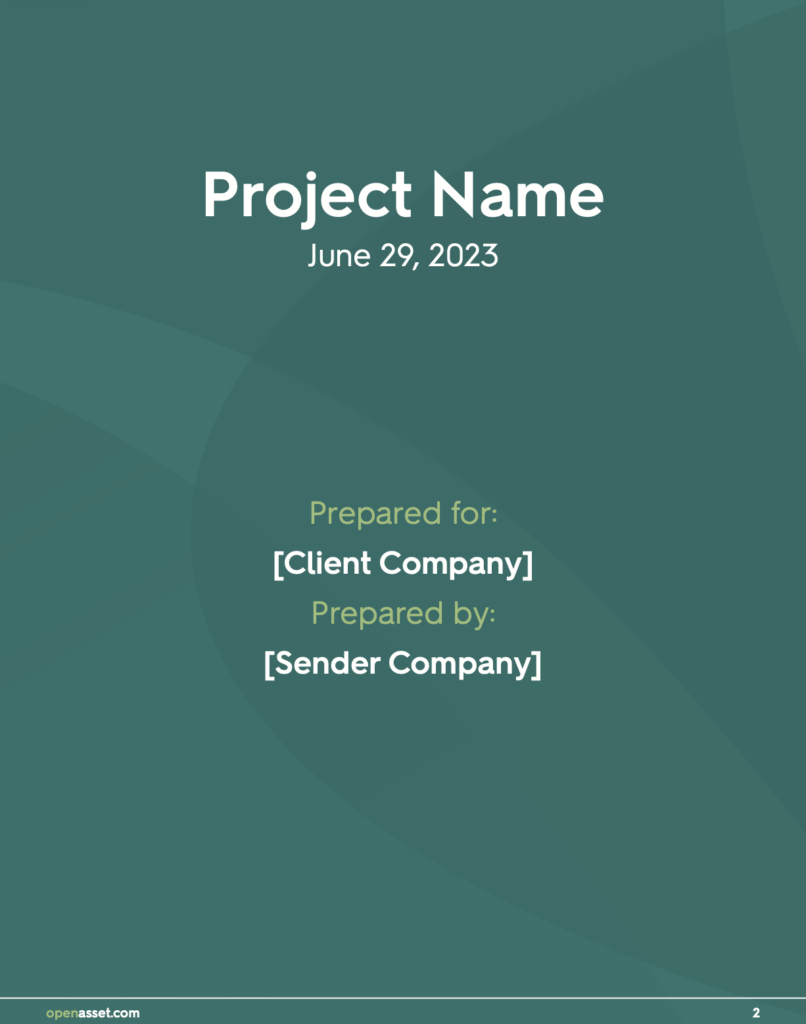
Cover Letter
The cover letter personalizes your engineering proposal. It should briefly introduce your organization, express your enthusiasm for the project, and highlight the key points that make your proposal stand out. This is your opportunity to establish a connection with the reader and encourage them to read further.
Introduction
The proposal introduction serves as the executive summary of your proposal. It should include an overview of your organization, the purpose of the proposal, and a summary of what the proposal will cover.
Make sure to clearly define the problem or opportunity your proposal addresses. Essentially, the introduction clarifies the purpose of crafting the proposal. It should lay out the foundation for why the proposal is necessary.
Additionally, the introduction should provide a concise overview of the proposal’s content. This summary needs to be engaging and offer a glimpse of the detailed descriptions to follow. It reveals your core idea and outlines the strategy you intend to use in delivering your services. Here’s an example of what a successful proposal introduction looks like:
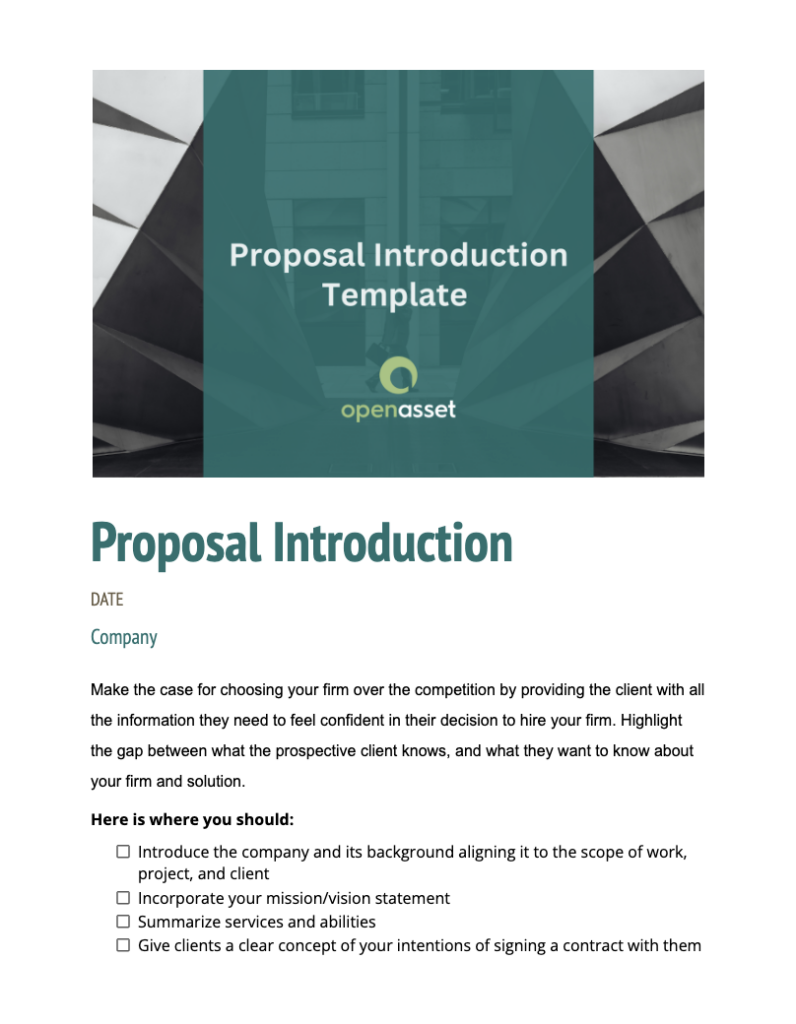

Project Background
This section delves into the details of the project. Describe the current situation, the specific problem or opportunity, and the objectives of the project. Providing a concise but thorough background helps the reader understand the context and the necessity of the proposed work.
You should illustrate the issue or situation that led to the creation of your proposal. In this section, it’s important to show a thorough comprehension of the problem at hand.
Qualifications
In this section, highlight your qualifications and experience relevant to the project. Detail your technical expertise, prior successful projects, and any unique skills or resources that make you stand out. This section reassures the client that you are capable of handling the project.
When writing this section, make sure to accurately highlight your skill set to emphasize your suitability for the project at hand. Consider this section as the part of your resume where you detail your skills and experiences.
While you should showcase your expertise, It’s also important to showcase, if relevant, your company’s proficiency and ability to successfully carry out the proposed task.
Project Team
Typically, an engineering proposal requires including details about each team member, their specific roles, and their professional backgrounds. The collective expertise of the project team often plays a critical role in the selection of a qualified engineering consultant, which is why the “Project Team” section is extremely important.
In this section, showcase the team that will work on the project. Ensure that every team member’s relevant experience is detailed in the proposal. Make sure to include brief employee bios in your RFP resumes that highlight each member’s qualifications and relevant experience. Just a few well-crafted sentences on such skills can make a significant difference.
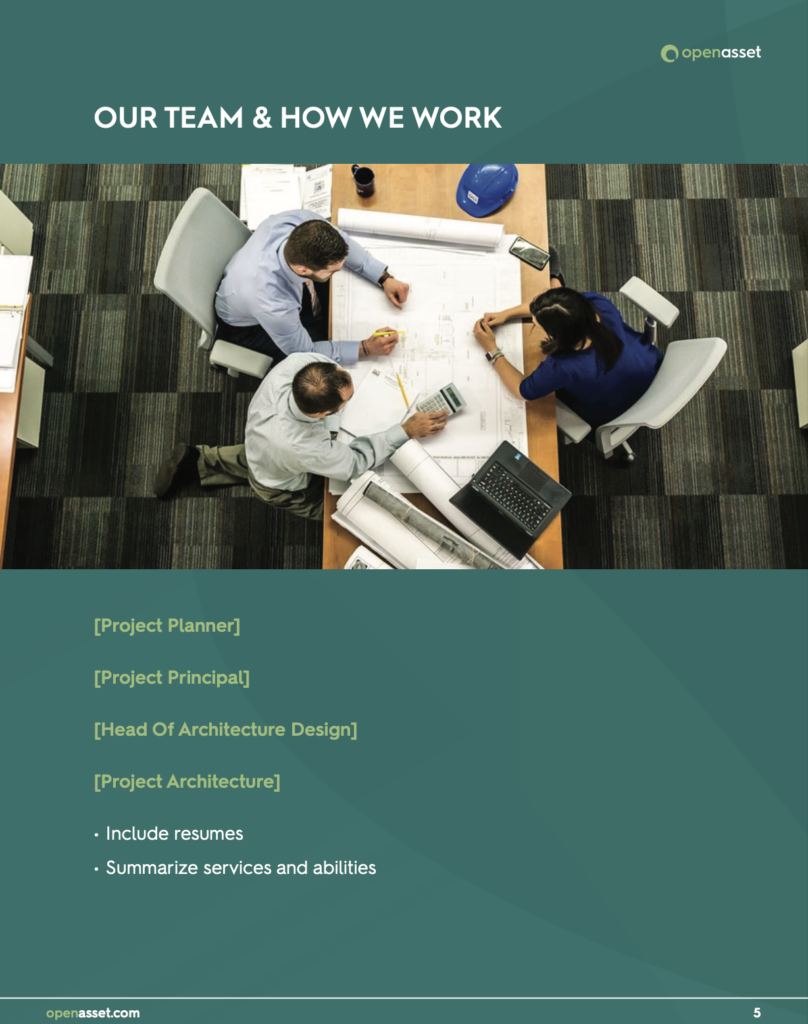
The right tools can help in creating and formatting these bios to present a professional image. With a robust digital asset management (DAM) solution like OpenAsset, you can cut down on the hours spent creating resumes and employee bios for engineering proposals.
A notable feature for employee bios is Content Assist, powered by OpenAsset’s Generative AI. It’s designed to assist users in creating project descriptions and employee bios within OpenAsset. In simple terms, Content Assist will analyze the existing data in your OpenAsset system to create original project descriptions and employee bios.
OpenAsset and the Employee Module enhance productivity within your organization by automating the creation of employee resume documents. This helps you present your team in the best light possible and quickest way possible.
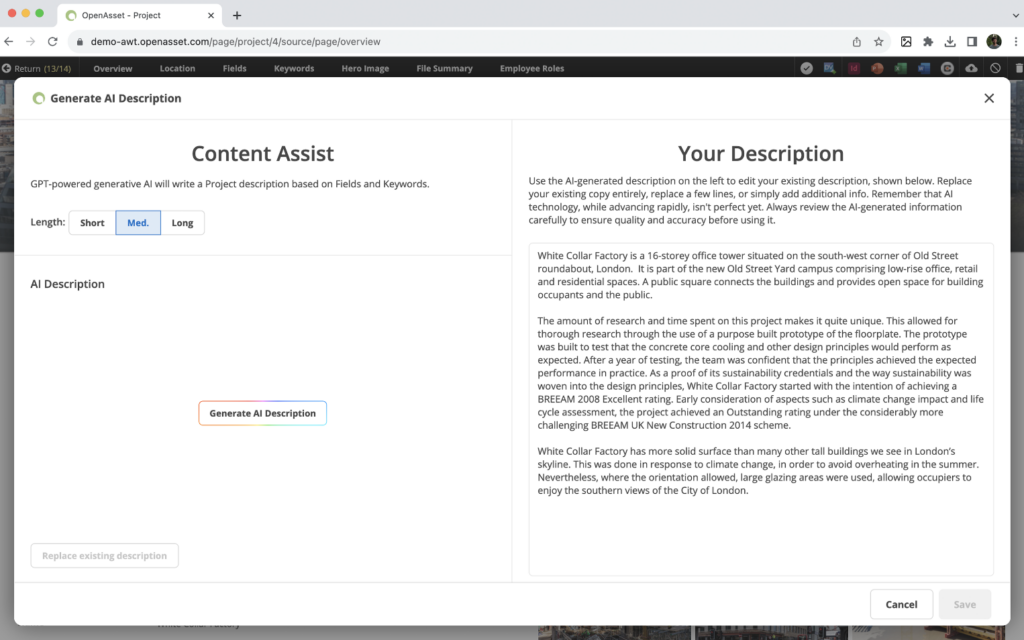
Remember, the strength of your team and how you present your team can be a significant deciding factor in winning the proposal.
Scope of Work
In the scope of work, you’ll want to detail the specific activities, deliverables, and timelines involved in the project. It’s crucial for an engineering proposal to precisely outline the project scope. Given that misunderstandings about project scope are a primary cause of project issues or failures, defining the scope with as much clarity is essential to prevent and more easily resolve problems.
Clearly outline the work that will be done, the methodologies used, and the expected outcomes. This section should align expectations and minimize misunderstandings about the project’s scope. When the scope is clearly defined, everyone involved understands the extent of work expected within the project’s framework.
Work Schedule
The work schedule section of the proposal does precisely what its name suggests: it monitors your work schedule.
Provide a detailed schedule of the project, including key milestones, deadlines, and dependencies. This section maps out the timeline for completing the project and is crucial as it informs your audience about the expected timelines and milestones.
The work schedule should be realistic and allow for some flexibility. You can enhance clarity by incorporating well-organized tables and specific time allocations. It’s also crucial to demonstrate your understanding of project management and your ability to complete the project on time.
Including a work schedule provides a professional touch to your proposal. Should you find yourself unable to stick to this schedule once the project has begun, it’s crucial to communicate any changes as soon as possible with the relevant parties.
Project Cost
Undoubtedly, the cost of engineering services holds significant weight in the decision-making process. The potential consultant is expected to define costs for each team member based on suitable hourly rates and the estimated hours needed for each stage of the project, along with a summary. While engineering associations recommend choosing consultants based on qualifications above cost, the reality is that pricing remains a key determinant.
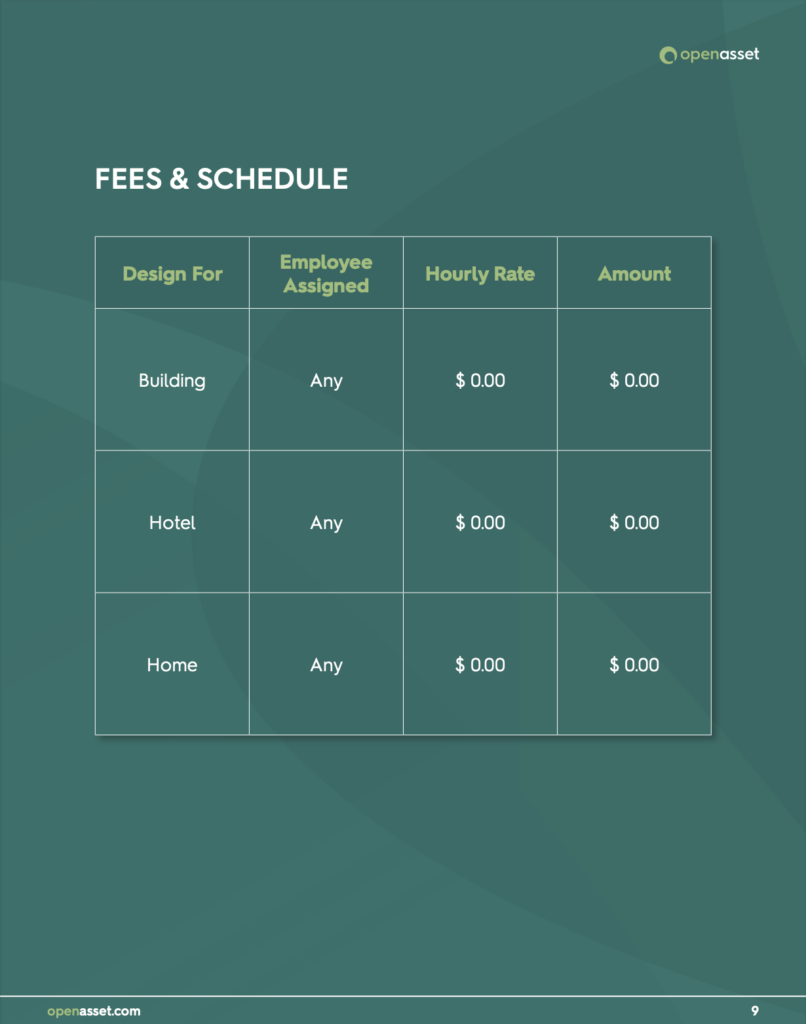
In this section, detail the expected expenses for your project by itemizing them and assigning monetary values to each category. Break down the costs into distinct groups, such as individual labor charges per employee, material costs, and so on. Summing up these figures will provide the total cost, offering the reader a clear financial overview.
This facilitates an informed decision-making process, allowing for a thorough assessment of different factors before committing funds.
Write a Strong Proposal Conclusion
The conclusion of the proposal mirrors the concluding section of a cover letter. Here, you should explain the reasons for considering you or your team as the ideal choice for the project and provide your contact information. It’s also an opportunity to reaffirm why you or your team is the most suitable candidate for the project.
Conclude your proposal by summarizing the main points, reiterating the benefits of choosing your organization, and expressing your eagerness to work on the project. End on a positive note, inviting further discussion or questions. You want to write a compelling conclusion that will leave a lasting impression on the reader.
| TIP: Want to know how OpenAsset saves you time and money on your engineering proposals while helping you win more business? Learn about the Top 10 Benefits of Using OpenAsset now. |
Expert Engineering Project Proposal Tips
To maximize your chances of winning projects with your engineering proposals, here are 12 proposal writing tips to keep in mind when crafting your next engineering proposal:
1. Read the RFP Multiple Times
Simply reading the Request for Proposal (RFP) is not enough; a deep understanding of the evaluation criteria is crucial. It’s essential to review the RFP carefully, taking in every detail beyond the basic requirements such as submission dates, formatting guidelines, and required signatures.
This thorough examination ensures you are aligned with all the requirements, conditions, and expectations outlined in the RFP. Such attentiveness not only aids in crafting a tailored response that aligns with the issuer’s needs but also minimizes the risk of non-compliance with the RFP’s requirements.
Moreover, upon reading a new RFP, it’s smart to draft a checklist detailing all essential criteria. This approach allows a good amount of time for you to make sure everything is included in your RFP response and allows you to request any necessary clarifications well in advance of the deadline.
2. Do Your Research
Undertaking comprehensive research is a cornerstone in the development of a compelling engineering proposal. This process involves gathering data, understanding industry standards, exploring the project’s context, and analyzing the potential impact of your work.
Research allows you to approach the project with a depth of knowledge that will reflect the feasibility, innovation, and planning of your proposal. It also provides a foundation for making informed decisions, identifying potential risks, and proposing effective solutions.
In essence, the research you conduct forms the backbone of a proposal that’s both convincing and achievable.
3. Create a Clear Proposal Format
If you’re wondering how to draft a proposal, starting with a clear format is a great start. Maintaining a clear engineering proposal format is fundamental to creating a structured and professional document. A standardized format ensures that the information is presented in an organized manner, making it easy for the reviewers to follow and evaluate. The format typically includes a well-defined table of contents, sections with clear headings, and a logical flow of information.
This structured approach helps display your message with precision and prevents critical elements from being overlooked. Consistency in format across various sections, such as the project background, scope, schedule, and qualifications, reinforces the overall flow of the proposal.
A well-formatted proposal not only reflects your professionalism but also helps in communicating the seriousness and preparedness of your team for the project.
4. Introduce Your Company’s Background
Introducing your company with a concise background in your engineering proposal is a critical step in setting the stage for a strong pitch. This section should provide a snapshot of your company’s history, core competencies, successes, and mission as they relate to the project in question. It’s an opportunity to establish credibility and build trust with the proposal’s reviewers.
This introduction should show the essence of your company’s identity, values, and the journey that has led to its current standing in the industry. Highlighting notable achievements, experience in similar projects, and the overarching vision can create a compelling narrative that resonates with the potential client.
A well-articulated company background serves as the foundation upon which the rest of the proposal is built, underlining why your firm is uniquely suited for the project.
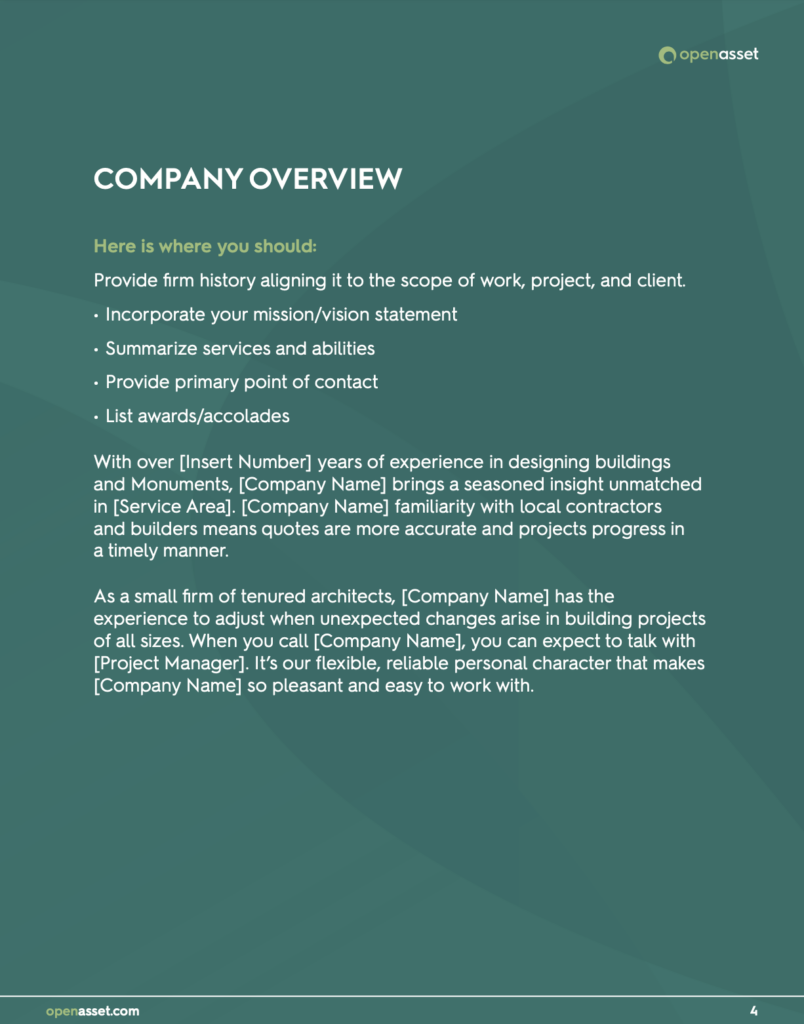

5. Feature Your Team’s Talent
In an engineering proposal, it’s important to select the best employees for your RFP response. Make sure to illustrate the unique skill sets, qualifications, and experiences that each member brings to the table. You can use this section to delve into the specific talents that differentiate your team from competitors.
Detailing individual roles and how they will contribute to the success of the project not only showcases the depth of your collective proficiency but also helps build confidence in your team’s ability to deliver results. Remember to align these talents with the project requirements, demonstrating a perfect fit between your team’s capabilities and the project’s needs.
If you’re looking to generate employee resumes in minutes that demonstrate your team’s talent, a robust DAM can help you store and manage employee profiles. A DAM for engineering like OpenAsset saves you time and resources in managing your resumes. Through the use of Generative AI, you can create project descriptions and employee RFP bios.
6. Include Images and Graphics
Incorporating images and proposal graphics into your engineering proposal can significantly enhance its impact. Civil engineering projects typically require various diagrams, illustrations, and maps. This is because the essence of designs is best conveyed through visual representation for complete clarity. The same principle applies to proposals, where visual elements are crucial for demonstrating complex information clearly and effectively.
Moreover, using images to communicate visually will save reading time for the client. The reader will also appreciate the amount of effort put into preparing the engineering proposal.
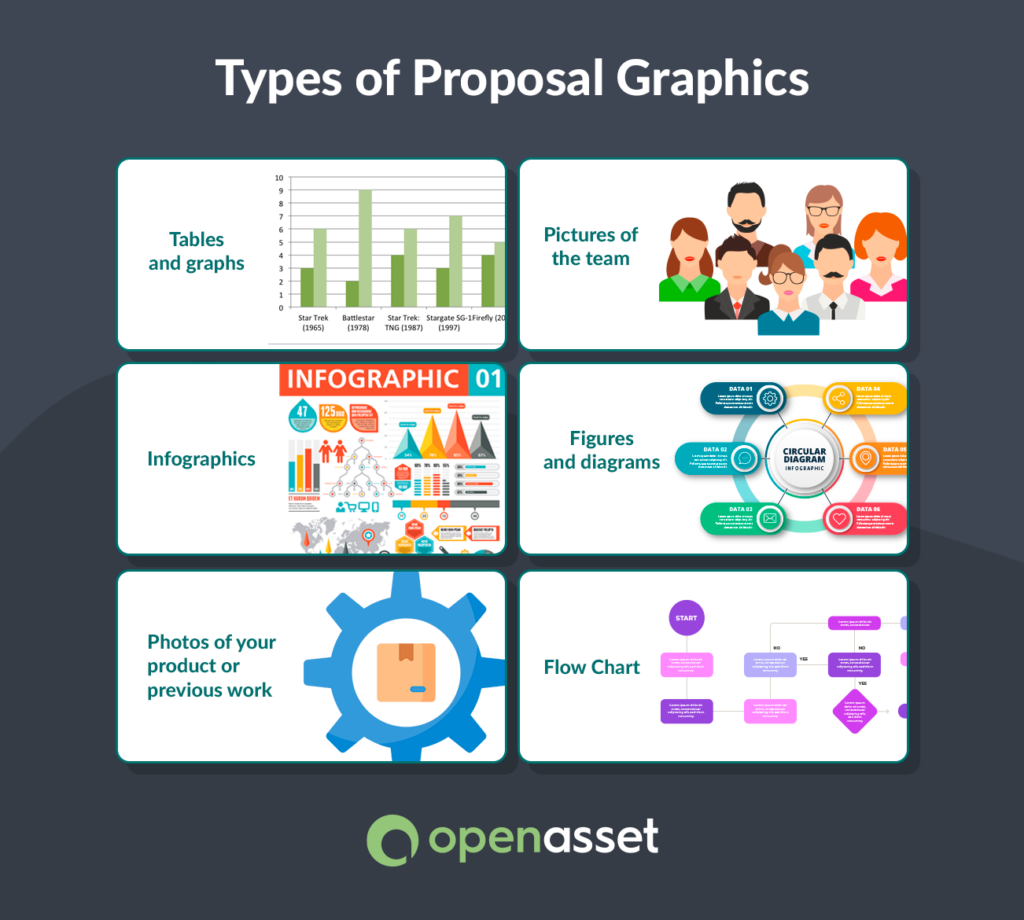
Use tools like OpenAsset to seamlessly find and present visuals of projects that align closely with the prospective client’s needs or showcase your team’s qualifications. This tailored visual approach not only shows your past successes but also provides a compelling, concrete visual narrative of what you can deliver.
Moreover, AI in DAM saves you time and resources in managing your images through AI-suggested keywords, image similarity search, AI Content Assist, and more. These features:
- Reduce the time it takes to manually tag images
- Helps you build and expand taxonomies
- Gives you additional images to select from and use.
- Enables you to leverage Generative AI for project descriptions and employee RFP bios
Images are not just embellishments; they can be powerful testimonials of your work’s relevance and quality, speaking volumes more than words alone.
7. Use Clear Language
Using clear and concise language is crucial when crafting an engineering proposal. The ability to demonstrate complex ideas effectively without resorting to overly technical jargon or unnecessarily complicated explanations is a skill that cannot be overstated.
Likewise, it’s important not to assume that the readers will be familiar with the specialized jargon of your field. Take time to research the client and the reviewing committee to grasp their expertise and knowledge base. When delving into detailed technical matters, ensure you offer sufficient background to maintain inclusivity and prevent any misunderstandings.
Proposals should be accessible, ensuring that stakeholders, regardless of their technical background, can grasp the proposed concepts and see the value in them.
Your team might possess attributes such as “remarkable efficiency, strong motivation, and outstanding qualifications,” yet, it’s likely that your competitors claim the same. Such language is often so overused in proposals that they become clichéd and lose their impact.
Rather than relying on generic adjectives, prove your capabilities with concrete examples of past projects or situations that illustrate your skills in action. Even more compelling would be citing testimonials or endorsements from previous clients who can vouch for your expertise. Here’s what that could look like in your proposal:
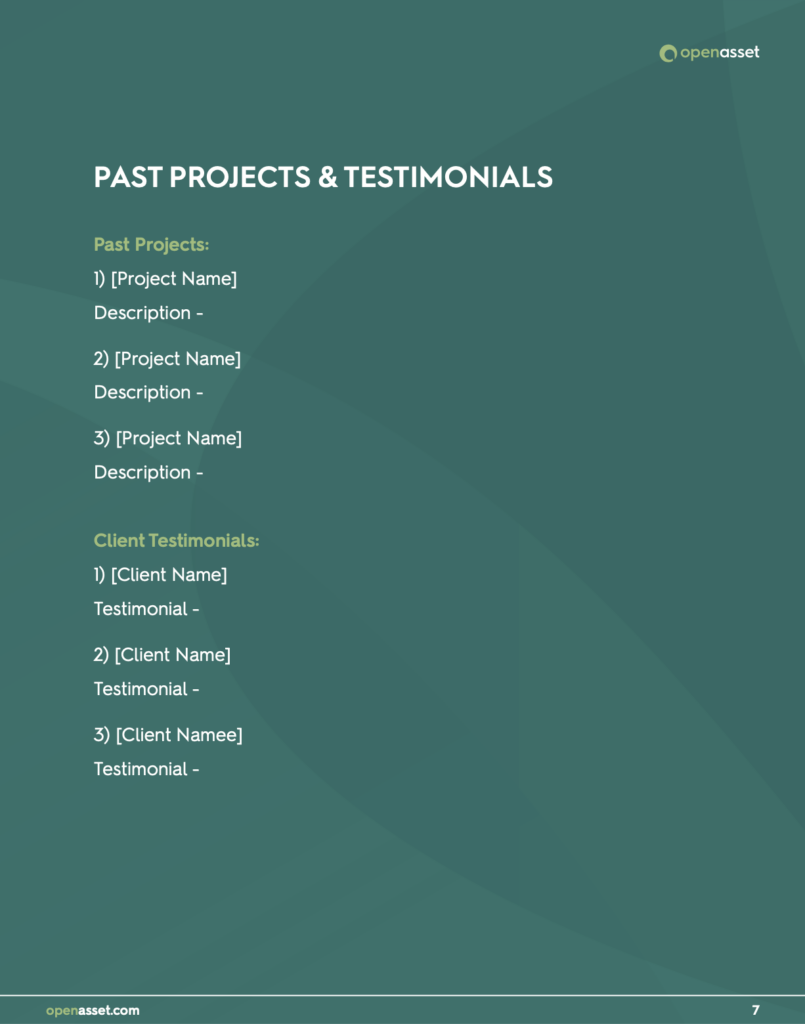
Additionally, avoiding excessive language not only helps in maintaining the reader’s attention but also demonstrates your ability to communicate efficiently. The proposal should be as concise as possible without sacrificing completeness. Every sentence should serve a purpose, whether it’s to inform, persuade, or clarify.
8. Keep It Short
Coming across an RFP with a large page limit or no page limit might give you the impression that you should create a significantly lengthy proposal. However, it’s best to resist this urge to write a 200-page proposal.
Keep in mind, your potential client will be comparing your proposal with several others. A concise submission allows them to quickly discern the essential details. Overloading your proposal with text increases the likelihood of them skimming over key points — steer clear of dense paragraphs.
A concise proposal not only respects the reviewer’s time but also enhances readability and comprehension. It’s essential to spread your message and value proposition without unnecessary elaboration. Precision in language, clarity in presenting solutions, and conciseness in your descriptions can make a powerful impact.
Moreover, a proposal that is straight to the point is often a sign of a well-thought-out project plan and a capable, organized team that knows how to communicate. A compact and well-structured proposal often speaks volumes about your project management skills and your respect for the client’s resources and time constraints.
9. Practice Teamwork
A collaborative approach ensures that diverse expertise and perspectives contribute to a more robust and comprehensive document. It’s the teamwork among team members, with their unique skill sets and experiences, that can elevate the quality of a proposal.
Working together with your team in the proposal process can lead to innovative solutions that might not surface in a siloed work environment. Teamwork facilitates thorough cross-checking, brainstorming, and problem-solving, which are essential to addressing the complex challenges typically presented in engineering projects.
Remember, surrounding yourself with an effective team is the key to success. A collaborative culture could be what makes you stand out from the competition.
Moreover, highlighting the collaborative nature of your team within the proposal can also serve as a testament to your capability to work together, a quality often wanted by clients. It’s not just about the final product but also about demonstrating the process of how your team works together to achieve excellence.
10. Proofread and Double-Check
Proofreading and carefully double-checking your proposal is as essential as the content itself. This step ensures that your document is free from errors, which could otherwise affect the credibility of your proposal. It’s not only about catching typos or grammatical mistakes; it’s about ensuring that every figure, fact, and statement aligns with the RFP requirements and your research findings.
A proposal that is well-edited and error-free communicates attention to detail and a commitment to excellence. It’s recommended to have multiple team members review the proposal to provide fresh perspectives and catch issues that you might have overlooked.
Remember, a single mistake could raise doubts about the professionalism of your work and the quality of the project delivery. Therefore, rigorous proofreading and double-checking are necessary to validate the integrity and professionalism of your engineering proposal.
11. Meet Deadlines
Meeting deadlines is important in the context of engineering proposals. The ability to deliver on time reflects your professionalism and reliability. It’s a non-negotiable element of project management that sets the stage for how potential clients view your commitment to the project’s success.
Planning is essential to ensure deadlines are not just met, but comfortably, allowing planning for any unexpected circumstances that might arise. Missing a deadline can have significant repercussions, from damaging your reputation to disqualification from the bidding process.
However, it’s not just about avoiding the negative. Following deadlines can also enhance your standing with clients, as it demonstrates respect for their time and trust in your ability to manage the project effectively from the start.
12. Submit the Proposal on Time
Part of meeting deadlines includes submitting your proposal on time. Every RFP specifies a submission deadline that must be met. Contrary to project deadlines, which may be subject to change during a project, the cut-off date for proposal submission is non-negotiable.
Physical submissions of hard copy proposals are often marked with an actual time stamp upon receipt. If that timestamp shows your submission arrived even one second past the deadline, it will unfortunately be too late.
With the rise in digital submissions, the strict adherence to deadlines continues. Considering potential issues like slow upload speeds or internet disruptions, it’s wise to plan additional time when submitting proposals electronically.
Make sure it’s clear how the proposal will be submitted so there are no surprises. You should also ask for help when it’s needed, especially if you are facing roadblocks and don’t have much time left.
Moreover, building buffer time for reviews and potential revisions is a wise strategy. Proposal writing often shows that tasks tend to extend beyond anticipated time frames. Whether you run out of printing paper or a team member makes a last-minute change, you need to be prepared. Therefore, allowing yourself a generous timeline for the preparation and submission of the final documents can mitigate the risk of missing the deadline.
Meeting deadlines reflect your professionalism and reliability, which are critical factors in the selection process. It demonstrates your commitment to the project timeline and sets the stage for the timely execution of the work ahead. Engineering proposals are also an investment of time and money and if you miss the deadline, this investment is wasted.
Additionally, a punctual proposal suggests that your project management and organizational skills are well-tuned, giving potential clients confidence in your ability to deliver results within the specified timeframe.
Free Engineering Proposal Template
At OpenAsset, we want to provide you with valuable resources to help pave the way toward success. That’s why we’re providing a free engineering project proposal template to inspire your proposal writing journey.
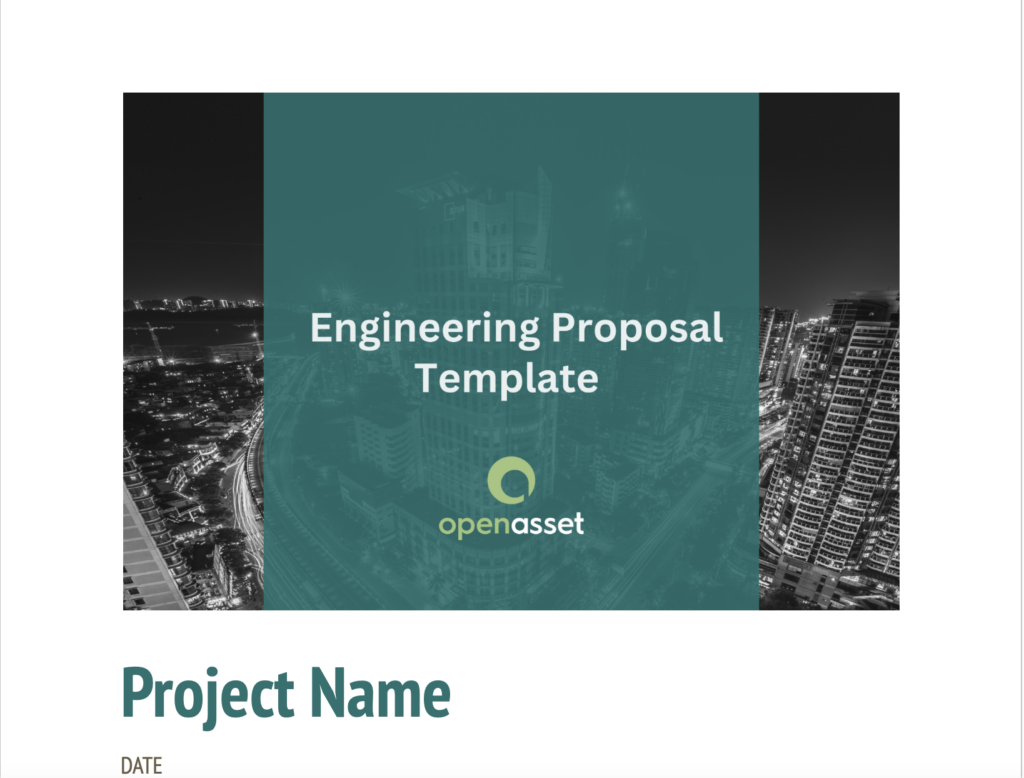
Use OpenAsset for Your Engineering Services Proposal
Leveraging a robust DAM, like OpenAsset, in your engineering proposals is a game-changer. OpenAsset streamlines the process of incorporating high-quality images and project data that represent your team’s past achievements and expertise.
By using OpenAsset, you can create a visually impactful and content-rich proposal that stands out. It not only saves valuable time by organizing your assets efficiently but also ensures that you present a polished, professional, and tailored proposal to your potential clients.
OpenAsset’s DAM solution makes AEC proposals simpler, faster, and more successful. That’s why 99% of customers renew. Leverage OpenAsset to elevate your proposals and effectively demonstrate why your team is the ideal choice for any AEC project.
Ready to start creating engineering proposals that will set you apart?
The post Engineering Proposals: Free Template + 12 Proposal Writing Tips appeared first on OpenAsset.